 Download this article in magazine layout
Download this article in magazine layout
- Share this article
- Subscribe to our newsletter
Women’s cooperative in the camel milk business shows resilience during drought
On the outskirts of Isiolo town, northern Kenya, our vehicle encounters a makeshift blockade of boulders and rocks, paralysing transport along the Nairobi-Moyale Highway. According to community and news reports, violence had broken out in retaliation to an attack of four Somali bomas or pastoral homesteads, killing three herders and raiding 160 to 200 camels. Violent conflicts have become more frequent as Kenya faces the worst climate-induced and protracted drought in 40 years. According to the International Federation of Red Cross and Red Crescent Societies, the drought in the Horn of Africa has left over 22 million people severely food insecure, with at least 5.5 million children facing acute malnutrition. Families in Kenya's semi-arid and arid regions have lost thousands of livestock in the crisis. Nomadic communities have crowded in a few remaining areas in search of food, water and pasture. In northern Kenya, Isiolo County is one of them.
Among pastoral communities in drought-prone regions, camels have enormous value. They provide milk and meat, draught-power, and are considered as long-term assets. A female camel can be sold for 100,000 to 180,000 Kenyan Shillings (675 to 1,200 €) and a male for 50,000 to 100,000 KSh (340 to 675 €) depending on the point of sale – with prices increasing from farm gate to local camel trading posts. For generations, camel milk (Kiswahili: maziwa ya ngamia) has been collected, sold and consumed. It is the preferred milk among communities in northern Kenya and Somalia, because of its availability and its medicinal and nutritional properties. Camel herding has been hailed a climate-resilient livelihood, and camel milk nicknamed “white gold” in the region. Camels have adapted to withstand 20 to 30 days without water, in comparison to two to three days among dairy cows. Even so, with little to no rainfall in the past five rain seasons, communities report that the camels’ milk production has dwindled significantly.
Approximately 60 per cent of camel milk from the surrounding counties of Isiolo is processed by Anolei Dairy Women’s Camel Milk Cooperative. It is a community group based in Isiolo town, which began as a self-help group organised by a handful of Somali women camel milk traders. In 2010, the group registered as a cooperative society, with a membership of over 100 women. The cooperative’s primary objective is to improve pastoral livelihoods and increase household income with the commercialisation of camel milk and camel milk products. While women control some of the major aspects of camel milk processing and trading, the animals are traditionally owned and herded by men. Since the emergence of Sharia-compliant banks in the region in 2012, female camel milk traders have had better access to credit and savings and better control of the monetary transactions across the camel milk value chain.
In 2021, Anolei Cooperative partnered with Egerton University, Kenya, the Natural Resources Institute at the University of Greenwich, UK, and the African Agriculture Knowledge Transfer Partnership (AAKTP) Programme to reduce post-harvest loss and advance the cooperative’s product development and general management. The AAKTP supports the cooperative through various initiatives, including co-development of feed compositions, training herders, increasing exposure to technical know-how for developing value-added camel milk products, improving existing products and strengthening relations with dairy institutions and stakeholders. Additionally, the business analytical and managerial capacities are to be enhanced through membership expansion, value chain analysis, market research and consumer awareness campaigns.
The camel milk value chain from udder to cup
Early in the morning, the herders prepare the milking containers. The majority of these containers are repurposed jerrycans that are washed when water is sufficient, sun-dried, and smoked using local species of woody plants (Somali name: Bil-ill or sabans, Acacia nilotica). Pastoral communities in Kenya have used smoke from certain herbs to disinfect milk-handling containers, preserve milk and give raw camel milk a characteristic desired flavour. Herders bring female camels to their calves, which suckle for a few minutes, stimulating the camels’ milk let-down. Milk is collected and poured into 5–20-litre jerrycans. Transporters drive or ride through rough terrains to collection points and to aggregating centres. Milk arrives at Anolei Cooperative from within a 150 to 200 km radius by bus or motorbike.
At the cooperative’s bulking and cooling facility, we had a glimpse of how milk was processed. From afternoon to night, a hired male technician tests and bulks hundreds of jerrycans of milk that are delivered. The cooperative members, the owners of the delivered milk, meet their transporter at a pre-arranged time to make sure the camel milk from their herd arrives and is accepted by the cooperative. The technician checks for spoilage by sight and scent. Spoilt milk can be rejected, but not without contestation by the transporter or owner, especially when camel milk is scarce and of great value. However, there is little wastage as rejected milk is taken away by the owner and usually sold at local markets as sour milk called suusa.
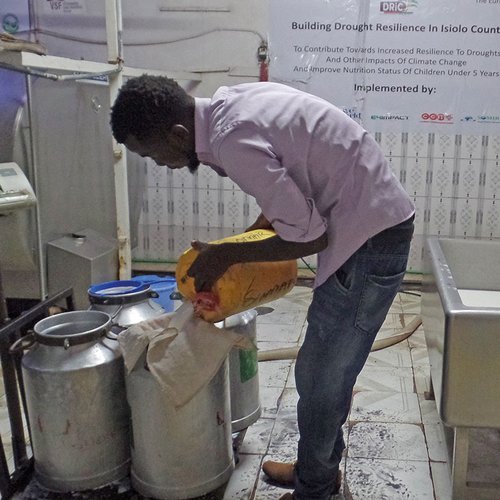
The technician pouring the milk into the aluminium milk cans.
For fresh milk that passes, the technician pours the milk into four aluminium milk cans that rest on an industrial scale. He holds two layers of cheesecloth in place inside a plastic sieve. Physical particles from the charcoal used for smoking the jerrycans are filtered, and the technician records the amount of milk against the member’s name in the register. The milk is emptied into a dump tank that is later pumped into a 3,000 litre cooling tank set at 4°C. The fresh milk is then chilled for a few hours, and in the morning, it is filled into 20-litre jerrycans to be ready for the six-hour journey to Nairobi’s Eastleigh market, 270 kilometres away. The cooperative has been delivering camel milk to Nairobi since 2010.
At the street corner of Eastleigh district, multiple two-wheeled handcart carriers emerge from all corners of the intersection just before the bus arrives. The transporters swiftly load the full jerrycans onto their carts and speed off to their respective retail points, mainly hotels, restaurants and milk distribution kiosks. Dotted around the street corners are milk stands. Women and men busily wash recycled plastic bottles, 750-ml to 2-litre, and sellers, mostly women, are ready to dispense camel milk into bottles for the mid-morning customers.
A long way to go
Anolei Cooperative has become a key node in the camel milk value chain, enabling pastoralists, herders, milk traders and intermediaries to establish their livelihoods around markets in the capital. However, this endeavour has not been without challenges. For instance, the cooperative’s facilities require an enormous amount of electricity to chill and store the daily camel milk deliveries, representing a significant operational cost for the cooperative, especially during the dry season when increased cooling is necessary. During the drought, the cooperative's income decreased given reduced milk production and trade. As a respected cooperative within the community, the group asked for payment deferrals to cope with the financial challenges.
To reduce dependence on the national grid, the cooperative is exploring options to search for suitable solar energy systems. An AAKTP associate based at the cooperative is assisting the members to seek support from various development organisations active in the county. Anolei Cooperative has also purchased a piece of land to construct a more permanent facility, eliminate rent and contribute to the cooperative’s vision of supplying camel milk to new markets in major cities in Kenya and beyond.
According to the AAKTP associate, another challenge is the adoption of standard tests to meet the quality for value addition. The technicians must aggregate five to six hundred of milk containers a day. They draw on their experience and test through sight and scent within seconds before the milk is poured and weighed. Although there has been training on post-harvest quality control, adoption is slow. There are significant constraints of time and resources. Most milk jerrycans will pass the sight and scent tests, but Anolei Cooperative and its partners would like to enable more scientific tests to be used in the future. In turn, improved hygiene and milk safety will contribute to the development of camel milk products such as camel yoghurt.
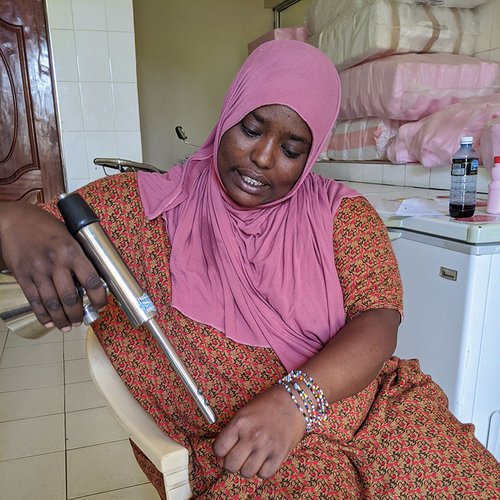
A member of Anolei Cooperative showing an instrument for alcohol testing, called an alcohol gun.
Since early 2022, Anolei Cooperative has formed a local partnership with the Tawakal Farmers Marketing Cooperative Society in Isiolo to develop flavoured camel yoghurt and camel meat products. Tawakal Cooperative has the facilities and license from the Kenyan Bureau of Standards to develop related food products. This partnership enabled the two groups to cope during the drought seasons. Amina, the Chairlady of Tawakal, explains that the orders of their yoghurt had dwindled from 100 to 200 litres a week to approximately 60 litres a week because of limited milk supply and demand.
Beyond similar electricity cost, annual operational cost includes the renewal of the national standard certifications for each flavour of the yoghurt products (current flavours: plain, strawberry, mango, pineapple, chocolate from essence produced by Promaco East Africa) and several county health certificates. In 2022, Tawakal Cooperative received a donation of a milk “ATM”, an automatic milk dispenser. It lies unplugged in a corner of their facility, waiting for the day camel milk supply is sufficient again.
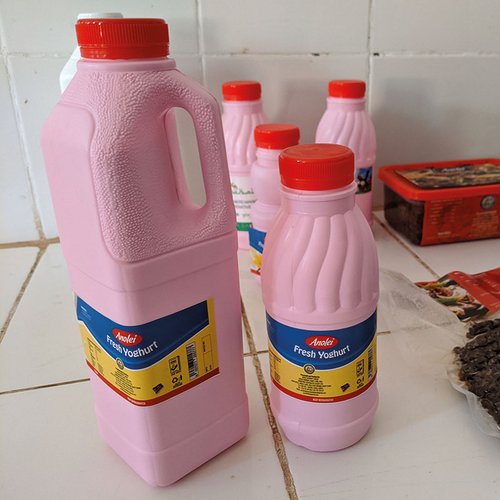
More value added through processing. Anolei Cooperative’s camel yoghurt.
While aluminium milk cans had been donated to herders and traders from several development organisations, we saw that many of these were piled up in a corner and unused. It seems unlikely that these large and bulky aluminium cans will be used by motorcycle transporters. Although the current use of jerrycans is problematic, given high risks of contamination and difficulties to clean the inner hollow handle, herders continue to incorporate traditional ways of smoking the interior of each jerrycan before collecting milk. It provides the smoky aroma of camel milk that regular consumers come to know and love.
Innovations are being developed, such as “mazzican”, which is made from food-safe and heat-stable plastics, with a large opening to reduce spillage. Its adoption has been tested by the International Livestock Research Institute. People gave low scores on usability and disliked its higher price. Meanwhile, small enterprises such as Savanna Circuit, a Kenyan specialist in solar cooling, are exploring smaller, more portable rectangular milk containers that can fit in a solar-powered cooler mounted on the back of a motorcycle. These milk containers are specially designed to carry small quantities, barcoded and geolocated to adapt to transporters going from dairy farm to farm or link herders within the vast terrain of the northern regions.
Efforts to improve the camel milk post-harvest hygienic practices along the value chain have faced multiple obstacles to innovation adoption. While Anolei Cooperative remains resilient to the increasingly severe weather events, we see a potential trade-off between safeguarding the availability and accessibility of a nutritious and local food source to existing consumers and the aim of expanding the camel milk industry to new markets and unfamiliar consumers through raising its food safety standards and, inevitably, its price. In April 2023, Amina shared good news: “It is raining, and things are good. Thank God, now the milk has increased.” For now, Anolei Cooperative and its community partners carry on, constantly looking for ways to strengthen the intricate network within the camel milk value chain.
The camel milk business
A lactating camel can produce 3–15 litres of milk a day. Camel milk production may vary depending on factors such as breed, health, diet and environmental conditions. Anolei members contribute one litre of milk as a share for every 20 litres of milk that is processed at the cooperative facilities. One share is equivalent to the going market price of camel milk, 120-140 Kenyan Shillings (KSh) per litre. As a reference, camel milk is more than three times the price of cow’s milk, approximately 40 KSh per litre according to prices in early 2023. As an average, Anolei Cooperative expects the production of 3,000 to 4,000 litres a day in the dry season and about 6,000 to 7,000 litres a day in the rainy season, which it has achieved. As the drought persisted in the start of 2023, Anolei Cooperative reported that the milk production has reduced to merely 2,000 litres a day. The Figure shows the average milk received at Anolei Women’s Cooperative and average rainfall for the years 2021 and 2022.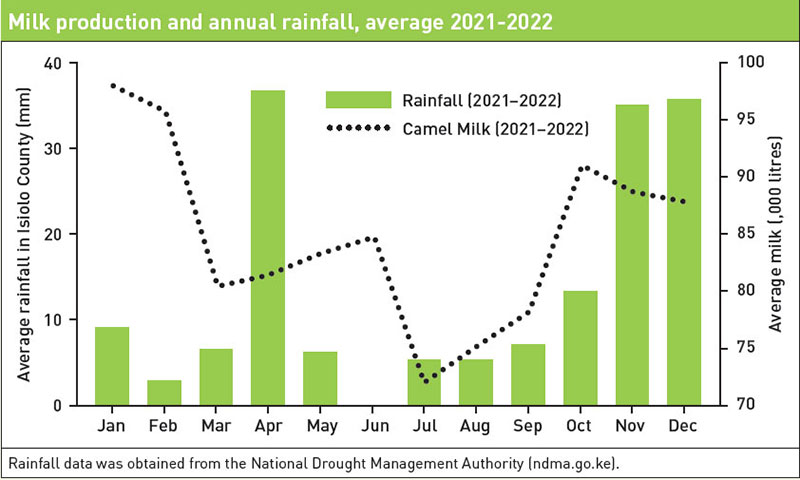
The Figure covers two particularly hard years for Isiolo County as it observed below long-term average rainfall and a drought was declared in several parts of the county. As the Figure shows, there is a strong correlation between camel milk production and average rainfall. Higher milk production was observed in the months of January/February and October/November 2022, which normally form the rainy season, and lower milk production was in the dry months of March, June and July. It will be interesting to look at the impact of additional factors, such as temperature, forage availability and management practices, on milk production in future studies.
June Po, a Senior Lecturer at the Natural Resources Institute of the University of Greenwich/UK, specialises in Gender and Diversity in Food Systems. Her research focuses on understanding the feedback and dynamics of social-ecological resilience.
Aditya Parmar, also at the Natural Resources Institute, is a Postharvest Scientist. His work revolves around the management and analysis of food supply chains, as well as postharvest biology and technology.
Joseph Matofari, an Associate Professor at Egerton University, is an expert in Food Safety and Microbiology. His work focuses on the processing and food safety of dairy products.
Contact: a.parmar(at)greenwich.ac.uk
The authors would like to express their sincere gratitude to Delia Randolph and John Nduko for their invaluable support in this project. Their expertise and guidance have been instrumental in shaping its success. A special thanks to project associate Kevin Miruye for all the hard work he has been doing at the Anolei Cooperative for the last 15 months. And a special thanks to Vétérinaires Sans Fontières Suisse (VSF-Suisse) for their long-term association with and support of Anolei Cooperative.


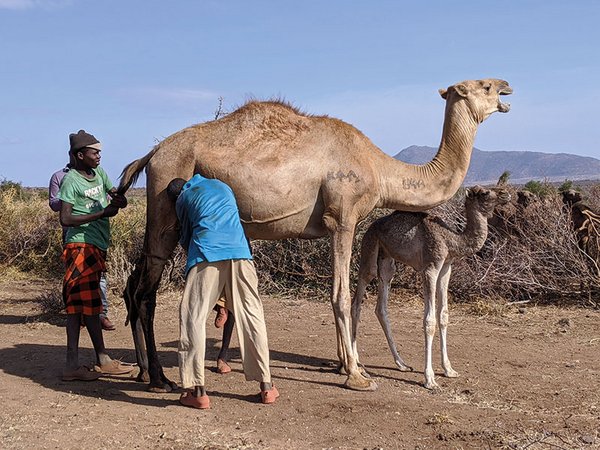


Add a comment
Comments :